A lovely surprise to hear of this article in Il Capoluogo that talks about my books. You may read it in Italian via this link or the English-translated version below. Some of the translation from Italian may come across a little differently in English. Interesting to find out how some of my posts are interpreted from afar, especially in Italy. (And in line with the article’s title, I can say that despite earthquakes, pandemics and all else that has kept me from the family house in Fossa, I still love the beauty and history of Fossa, the Aterno Valley and Abruzzo and now that I’ve finished, The Proxy Bride, I’m delving back into this remarkable area of Italy and some unanticipated family trails for my next book.) Many thanks to giornalista, Sergio Venditti for the article.

PERSONAGGI
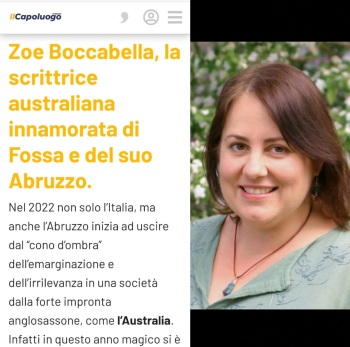
Zoë Boccabella, the Australian writer in love with Fossa and its Abruzzo.
by Sergio Venditti
In 2022, not only Italy, but also Abruzzo begins to emerge from the “shadow cone” of marginalisation and irrelevance in a society with a strong Anglo-Saxon imprint, such as Australia. In fact, in this magical year a real political-institutional miracle took place with the election as Prime Minister of that great country the Hon. Anthony Albanese, son of an Apulian from Barletta (known only in 2011) and raised by a single mother. An outcome that was not taken for granted, with the victory of Labor, after a decade under conservative leadership, but who wanted to experience change in the post-pandemic. The Albanian government has thirteen ministers, even with a representation of Islamic faith. At his oath, the Prime Minister declared, “I am proud of my government, which reflects Australia in its inclusiveness and diversity”.
Of course, half a century has passed since that film by L. Zampa (“A Girl in Australia” starring C. Cardinale and A. Sordi), which made an era: “Handsome, Honest, Australian Emigrant would marry a respectable countrywoman”. The critic G. Grazzini wrote about the film: “It is not only fun, it evokes the nostalgia for the distant homeland…. where everything is possible “. In fact, in recent decades the Italian community has conquered, with tenacity, a central space in Australian society, as already highlighted in all fields.
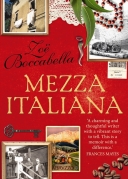 This is also the case for an emigrant like Annibale, who arrived in the country from his small village of Fossa in the province of L’Aquila. Childhood memories of him are now inspirational for his granddaughter, Zoë Boccabella, an emerging author. The latter reports her family background in the book: “Mezza Italiana“, featured in a 2019 interview (to Abruzzo Economia): “I grew up as a descendant of Italian immigrants in the 70s and 80s, when having Mediterranean origins it was not as well regarded as it is now”.
This is also the case for an emigrant like Annibale, who arrived in the country from his small village of Fossa in the province of L’Aquila. Childhood memories of him are now inspirational for his granddaughter, Zoë Boccabella, an emerging author. The latter reports her family background in the book: “Mezza Italiana“, featured in a 2019 interview (to Abruzzo Economia): “I grew up as a descendant of Italian immigrants in the 70s and 80s, when having Mediterranean origins it was not as well regarded as it is now”.
In this autobiographical book, Zoë describes her discovery of Abruzzo and her home in Fossa (damaged in the same 2009 earthquake). In these memories, Boccabella touches the central heart of the return to the origins: “The first time I travelled to Abruzzo, where my paternal grandfather comes from, I had the feeling of returning home”.
Thus visiting Calabria itself, from which her grandmother came. And again memory becomes writing: “Walking through villages, hills, woods and abandoned castles, I felt that Abruzzo was a unique land” and … “I was reflecting more and more on my life experience … and on how I felt divided in half, as if I did not entirely belong to either culture”.
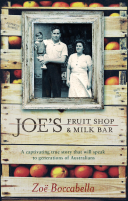 A journey to rediscover her origins as Zoë (with her husband Roger), after a childhood in which she was sometimes harassed at school, in Brisbane (in the north-eastern state of Queensland), insulted as a “Wog“, for non-Anglo-Saxon immigrants. “I started writing what would become ‘Mezza Italiana’, while I was sitting at the kitchen table of our family house in Fossa”. Still in the kitchen, this time in Australia, Zoë describes: “pumpkins, which we bought from a farmer, along the road, near Esk”. And after also their symbolic role in the land of the ancestors: “For centuries in Abruzzo pumpkins have remained a significant part of folklore and the agricultural calendar, with late autumn, which was a moment of reconciliation and gratitude at the end of the harvest” … “With the end of the seasons the arrival of the moment of gratitude for those who preceded us, who have now disappeared”.
A journey to rediscover her origins as Zoë (with her husband Roger), after a childhood in which she was sometimes harassed at school, in Brisbane (in the north-eastern state of Queensland), insulted as a “Wog“, for non-Anglo-Saxon immigrants. “I started writing what would become ‘Mezza Italiana’, while I was sitting at the kitchen table of our family house in Fossa”. Still in the kitchen, this time in Australia, Zoë describes: “pumpkins, which we bought from a farmer, along the road, near Esk”. And after also their symbolic role in the land of the ancestors: “For centuries in Abruzzo pumpkins have remained a significant part of folklore and the agricultural calendar, with late autumn, which was a moment of reconciliation and gratitude at the end of the harvest” … “With the end of the seasons the arrival of the moment of gratitude for those who preceded us, who have now disappeared”.
“The cocce de morte” (heads of the dead), are carved in the pumpkins and inside with a lit candle to illuminate, welcoming the loved ones of the past, to join those present and their homes “. In this, Zoë Boccabella represents a cultured writer (with a degree in Literature and Sociology, with a master’s degree in Philosophy), determined and coherent in her narrative plots.
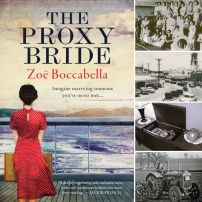 Now she announces her third book, forthcoming, entitled “The Proxy Bride“, which takes up the old custom of proxy weddings in a foreign land. An extraordinarily lively novel, “About family, secrets and adversity, imagining marrying someone you’ve never met. How she arrived in Australia on a bridal ship, among many brides by proxy, knowing little of the husbands they had married from afar, most of them coming to find someone, very different from what was described “.
Now she announces her third book, forthcoming, entitled “The Proxy Bride“, which takes up the old custom of proxy weddings in a foreign land. An extraordinarily lively novel, “About family, secrets and adversity, imagining marrying someone you’ve never met. How she arrived in Australia on a bridal ship, among many brides by proxy, knowing little of the husbands they had married from afar, most of them coming to find someone, very different from what was described “.
The author recalls the same added value of feminist culture, in “Three Shades of Mimosas“, as a symbol to celebrate the first International Women’s Day, in 1946. A shared appeal also to denounce the Russian invasion, the loss of many paintings by the Ukrainian artist M. Prymachenko (1909-1997), with her symbolic work, “A Dove Has Spread Her Wings and Asks for Peace”, 1982. Yet a great Russian literature like F. Dostoevsky wrote: “Man loves to build and trace roads, he is peaceful. But where does it come from that you also passionately love destruction and chaos”.
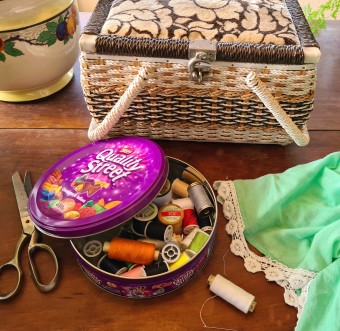 Mending… so out comes the sewing box Nanna Francesca gave me for my 8th birthday. I can’t tell you how disappointed I was to receive this as a present at that age, though I put on a happy face so not to hurt her feelings. Afterwards, I told Mum she could have it and the sewing box sat in her linen press for years. Yet, once I moved into my own house, I went and retrieved it and it has stayed with me.
Mending… so out comes the sewing box Nanna Francesca gave me for my 8th birthday. I can’t tell you how disappointed I was to receive this as a present at that age, though I put on a happy face so not to hurt her feelings. Afterwards, I told Mum she could have it and the sewing box sat in her linen press for years. Yet, once I moved into my own house, I went and retrieved it and it has stayed with me.
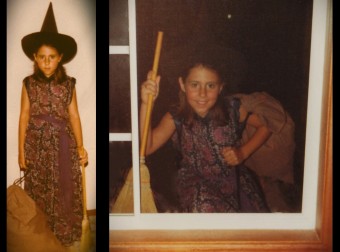 Tonight is Epiphany Eve and in Italy many children will be waiting to see what they receive from La Befana, ‘the witch’ – sweets if they’ve been good, coal if they’ve been naughty. As I wrote in, Mezza Italiana, I was chosen as La Befana for my school play, being ‘an Italian kid’, and as you can see from the first photo, I wasn’t too thrilled about it! 😄 Although, I’d warmed up to the idea by the second photo when I got to climb through a window. (As you can also see, being summer, I’m already a bit burnt from swimming at the local pool!)
Tonight is Epiphany Eve and in Italy many children will be waiting to see what they receive from La Befana, ‘the witch’ – sweets if they’ve been good, coal if they’ve been naughty. As I wrote in, Mezza Italiana, I was chosen as La Befana for my school play, being ‘an Italian kid’, and as you can see from the first photo, I wasn’t too thrilled about it! 😄 Although, I’d warmed up to the idea by the second photo when I got to climb through a window. (As you can also see, being summer, I’m already a bit burnt from swimming at the local pool!) A part of my Italian-Australian life in two photos… the first one – Nanna Francesca (centre) taking her visiting cousins from Sydney to Qld’s Big Pineapple. To me, there’s something about seeing these three Italian migrant women standing in front of something so Australian, knowing how my nonna loved going there and knowing how it was a world away from their stone villages in Italy. Nanna Francesca brought me back an enormous Big Pineapple pencil with a pineapple on the end of it. I was about five (and still have it!) She also bought herself a Big Pineapple tea-towel and salt and pepper shakers.
A part of my Italian-Australian life in two photos… the first one – Nanna Francesca (centre) taking her visiting cousins from Sydney to Qld’s Big Pineapple. To me, there’s something about seeing these three Italian migrant women standing in front of something so Australian, knowing how my nonna loved going there and knowing how it was a world away from their stone villages in Italy. Nanna Francesca brought me back an enormous Big Pineapple pencil with a pineapple on the end of it. I was about five (and still have it!) She also bought herself a Big Pineapple tea-towel and salt and pepper shakers.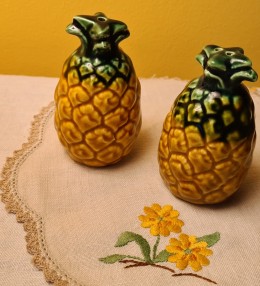 These shakers – in the second photo – sat, never used, behind glass in her ‘good’ cabinet, for decades. Then, after my grandparents had both died and the family was packing up their house of more than fifty years, I found myself standing in front of this cabinet looking at those two pineapples. Yes, they were kitschy but I couldn’t let them end up lost, so now they sit on a bookshelf in my kitchen, a little reminder of Nanna Francesca that makes me smile.
These shakers – in the second photo – sat, never used, behind glass in her ‘good’ cabinet, for decades. Then, after my grandparents had both died and the family was packing up their house of more than fifty years, I found myself standing in front of this cabinet looking at those two pineapples. Yes, they were kitschy but I couldn’t let them end up lost, so now they sit on a bookshelf in my kitchen, a little reminder of Nanna Francesca that makes me smile. I never expected to end up with a collection of linens that span four generations of women on both sides of my family. Especially since, as a teenager, I’d hope for the latest record for my birthday only to be disappointed when Nanna Francesca gave me tablecloths ‘for my Glory box’. Again. For years these sat unused along with the tea towels, doilies and other items I also had no interest in then.
I never expected to end up with a collection of linens that span four generations of women on both sides of my family. Especially since, as a teenager, I’d hope for the latest record for my birthday only to be disappointed when Nanna Francesca gave me tablecloths ‘for my Glory box’. Again. For years these sat unused along with the tea towels, doilies and other items I also had no interest in then.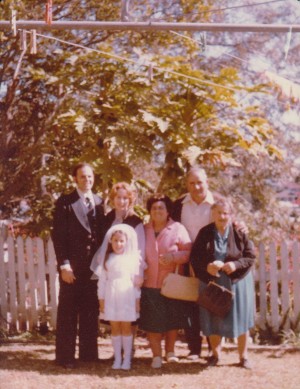 This old photo is pretty faded and scratched but the main reason I chose to share it with you on Mother’s Day is that it’s a rare one showing together in a row three generations of women in my family who were mothers to me – Mum, Nanna Francesca and Great-Granny Maddalena.
This old photo is pretty faded and scratched but the main reason I chose to share it with you on Mother’s Day is that it’s a rare one showing together in a row three generations of women in my family who were mothers to me – Mum, Nanna Francesca and Great-Granny Maddalena. It was actually Nonno Anni who originally gave me the idea for, The Proxy Bride. When I was talking to him about his life for Joe’s, he mentioned by chance that during WW2 when he and other Italian men were taken from farms around Stanthorpe and sent to internment camps, the women and children suddenly left alone did it very tough. He later heard they were given no assistance and with curfews and restrictions weren’t allowed to drive, many didn’t know how to use the farm equipment or ride a horse and faced poverty and starvation. He mentioned this group of women who banded together to keep their farms going. That really struck me and I felt I’d come back and write about it. When I learnt that some of these women were also proxy brides, it opened up more to the story.
It was actually Nonno Anni who originally gave me the idea for, The Proxy Bride. When I was talking to him about his life for Joe’s, he mentioned by chance that during WW2 when he and other Italian men were taken from farms around Stanthorpe and sent to internment camps, the women and children suddenly left alone did it very tough. He later heard they were given no assistance and with curfews and restrictions weren’t allowed to drive, many didn’t know how to use the farm equipment or ride a horse and faced poverty and starvation. He mentioned this group of women who banded together to keep their farms going. That really struck me and I felt I’d come back and write about it. When I learnt that some of these women were also proxy brides, it opened up more to the story. Also, since I mentioned in my last post that Nanna Francesca would’ve been especially happy to see, The Proxy Bride in the Australian Women’s Weekly, I thought I should mention the same might’ve been for Nonno Anni regarding a recent article about my books appearing in the Italian Australian newspapers, Il Globo and La Fiamma (full article in Italian online). I have lovely memories of him at the kitchen table often reading one of these newspapers with a morning coffee (International Roast boiled on the stove in the enamel pot, of course!)
Also, since I mentioned in my last post that Nanna Francesca would’ve been especially happy to see, The Proxy Bride in the Australian Women’s Weekly, I thought I should mention the same might’ve been for Nonno Anni regarding a recent article about my books appearing in the Italian Australian newspapers, Il Globo and La Fiamma (full article in Italian online). I have lovely memories of him at the kitchen table often reading one of these newspapers with a morning coffee (International Roast boiled on the stove in the enamel pot, of course!) On the kitchen table today… roses and lemons from a friend’s garden. (With glorious fresh, crisp and sweet musky scents!) The vase came from Nanna Francesca’s ‘good cabinet’ and was a bonbonniere from a 1970s or 80s Italian wedding. (Some will remember those!) It’s
On the kitchen table today… roses and lemons from a friend’s garden. (With glorious fresh, crisp and sweet musky scents!) The vase came from Nanna Francesca’s ‘good cabinet’ and was a bonbonniere from a 1970s or 80s Italian wedding. (Some will remember those!) It’s 




 Bisnonna Francesca… a companion post to the previous on Bisnonno Domenico. Likewise, I didn’t get to meet her yet each photo has a little to reveal and brings the past somewhat closer in that moment. A rare photo, circa 1930 (bottom right) shows Francesca in Palmi, Calabria with her mother, Soccorsa, the baker and her daughter (Nanna Francesca). The three who lived together for years after Domenico was in Australia. And then (top left), just Francesca and her daughter, soon to leave to join him in 1934. She and her mother had worked hard to help raise the ship fares, determined as she was to be reunited.
Bisnonna Francesca… a companion post to the previous on Bisnonno Domenico. Likewise, I didn’t get to meet her yet each photo has a little to reveal and brings the past somewhat closer in that moment. A rare photo, circa 1930 (bottom right) shows Francesca in Palmi, Calabria with her mother, Soccorsa, the baker and her daughter (Nanna Francesca). The three who lived together for years after Domenico was in Australia. And then (top left), just Francesca and her daughter, soon to leave to join him in 1934. She and her mother had worked hard to help raise the ship fares, determined as she was to be reunited. In his work clothes (top left), one knee patched, behind him his Applethorpe orchards on land he’d hand-cleared, long before he could afford the horse.
In his work clothes (top left), one knee patched, behind him his Applethorpe orchards on land he’d hand-cleared, long before he could afford the horse.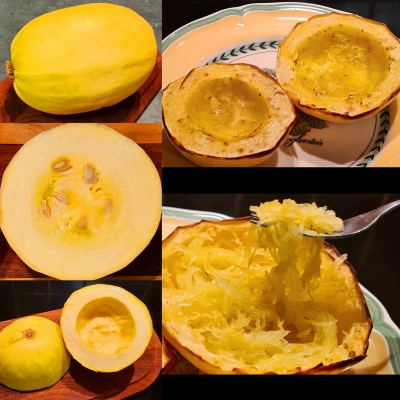 Spaghetti squash… a sunny winter vegetable. It grows on a vine like pumpkin and has yellow, star-shaped blossoms that only open for one day. Love how, once tender, you can gently fork the strands from the sides to create spaghetti in its own bowl.
Spaghetti squash… a sunny winter vegetable. It grows on a vine like pumpkin and has yellow, star-shaped blossoms that only open for one day. Love how, once tender, you can gently fork the strands from the sides to create spaghetti in its own bowl.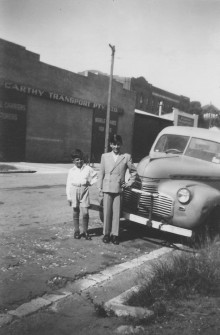 A post script – there were too many little incidents to include them all in,
A post script – there were too many little incidents to include them all in, 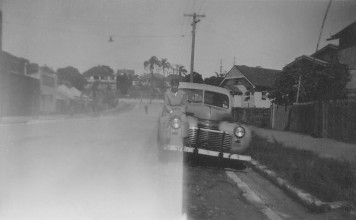 Perhaps I was a bit too sentimental in my previous post, (I can be at the best of times!) It might’ve been because Wyandra Street features so strongly in my family history and now, little remains of how the area once was and another bit will soon vanish. But I accept life keeps going on, change happens and so it is. In the meantime, we connect and live on in our stories and I feel very blessed to be able to share these stories with you and to hear yours in return. Gentile auguri! Zoe xx
Perhaps I was a bit too sentimental in my previous post, (I can be at the best of times!) It might’ve been because Wyandra Street features so strongly in my family history and now, little remains of how the area once was and another bit will soon vanish. But I accept life keeps going on, change happens and so it is. In the meantime, we connect and live on in our stories and I feel very blessed to be able to share these stories with you and to hear yours in return. Gentile auguri! Zoe xx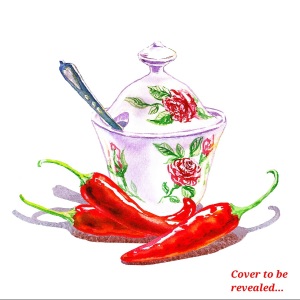 The Proxy Bride is a novel inspired by true stories and set between the 1940s and the 1980s in Italy and Australia. There will be angry spaghetti, mixed grills, mixed tapes, Dean Martin on the 1950s stereogram and plastic on the lounge suite and, above all, hopefully characters you may come to love who band together amid tough times for a new life.
The Proxy Bride is a novel inspired by true stories and set between the 1940s and the 1980s in Italy and Australia. There will be angry spaghetti, mixed grills, mixed tapes, Dean Martin on the 1950s stereogram and plastic on the lounge suite and, above all, hopefully characters you may come to love who band together amid tough times for a new life. I have this one treasured photo with three generations of the Boccabella men in my life – Dad, Nonno Anni, Bisnonno Vitale (and my zio).
I have this one treasured photo with three generations of the Boccabella men in my life – Dad, Nonno Anni, Bisnonno Vitale (and my zio).
 Polpette and peas in gravy, such an ‘Australitaliano’ combination – meatballs and peas in tomato sauce. Comfort food at its best. Nanna Francesca cooked this a lot (and when I was a kid, I found it a bit confusing that, being southern Italian, she called the tomato passata or sugo – ‘gravy’ considering my Australian Mum called gravy a deep-brown liquid accompanying a roast). Nanna Francesca would’ve been 95 today so it seems fitting to cook her polpette e piselli in gravy. We always celebrated her birthday on the 12th, the day she was born though the official date on her birth certificate was the 19th (lodged late as her parents argued who to name her after). Tradition won, as did her father, and being the first-born, Francesca was named after her paternal grandmother.
Polpette and peas in gravy, such an ‘Australitaliano’ combination – meatballs and peas in tomato sauce. Comfort food at its best. Nanna Francesca cooked this a lot (and when I was a kid, I found it a bit confusing that, being southern Italian, she called the tomato passata or sugo – ‘gravy’ considering my Australian Mum called gravy a deep-brown liquid accompanying a roast). Nanna Francesca would’ve been 95 today so it seems fitting to cook her polpette e piselli in gravy. We always celebrated her birthday on the 12th, the day she was born though the official date on her birth certificate was the 19th (lodged late as her parents argued who to name her after). Tradition won, as did her father, and being the first-born, Francesca was named after her paternal grandmother.

 “On Boxing Day, Annibale, Francesca and the others loaded the back of the Chevrolet with cold drinks, some roast chickens and a couple of large watermelons. After several years of keeping the fruit shop and milk bar open almost every day, Annibale had decided they’d close for a couple of days over Christmas and the family would head to the beach for the day…
“On Boxing Day, Annibale, Francesca and the others loaded the back of the Chevrolet with cold drinks, some roast chickens and a couple of large watermelons. After several years of keeping the fruit shop and milk bar open almost every day, Annibale had decided they’d close for a couple of days over Christmas and the family would head to the beach for the day… Nonno Anni told me when he received an orange for Christmas during his childhood in the 1920s, he treasured it. I knew he and his Mum were poor and village life in Italy was hard at that time, especially with his father far away in Australia to seek work, but an orange… I couldn’t quite believe it when I found this out as a child in the 1970s and oranges were so easy to get then. But fresh oranges were considered treasures before refrigeration and faster transport. Especially at Christmas considering that since ancient times, oranges have been said to bring joy, good luck and to ward off evil. (What must Nonno Anni have thought once he had a whole display of oranges at his fruit shop and milk bar!)
Nonno Anni told me when he received an orange for Christmas during his childhood in the 1920s, he treasured it. I knew he and his Mum were poor and village life in Italy was hard at that time, especially with his father far away in Australia to seek work, but an orange… I couldn’t quite believe it when I found this out as a child in the 1970s and oranges were so easy to get then. But fresh oranges were considered treasures before refrigeration and faster transport. Especially at Christmas considering that since ancient times, oranges have been said to bring joy, good luck and to ward off evil. (What must Nonno Anni have thought once he had a whole display of oranges at his fruit shop and milk bar!)
 If I’m honest, Christmas isn’t always the easiest time for me as it feels bittersweet with the happiness of those present mingled with the quiet of those unable to be or now gone. But food is so special in that certain dishes can trigger those lovely memories of people dear to us no matter how long it may be since we’ve seen them and this year, I feel happy that oranges can bring that little bit of sunshine.
If I’m honest, Christmas isn’t always the easiest time for me as it feels bittersweet with the happiness of those present mingled with the quiet of those unable to be or now gone. But food is so special in that certain dishes can trigger those lovely memories of people dear to us no matter how long it may be since we’ve seen them and this year, I feel happy that oranges can bring that little bit of sunshine. Warmest wishes and thank you for your lovely support and messages throughout the year. May 2020 be filled with light and some happiness no matter what else it may bring! Wishing you tante belle cose – many beautiful things, Zoe xx
Warmest wishes and thank you for your lovely support and messages throughout the year. May 2020 be filled with light and some happiness no matter what else it may bring! Wishing you tante belle cose – many beautiful things, Zoe xx Doing things like an Italian you’d never have thought you would when growing up…
Doing things like an Italian you’d never have thought you would when growing up… 
